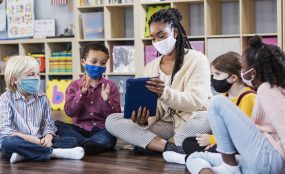Schools
Developing personal health literacy—the ability to find, understand, and use health information and services—should start early in life. Teaching health literacy skills is part of the process of caring for and educating children, adolescents, and young adults. All students should graduate with skills that will help them lead healthier lives.
The resources on this page can help childcare providers, early childhood educators, K-12 (kindergarten through grade 12) teachers, and university faculty recognize and respond to students’—and their family members’—health information and communication needs.
The resources may also help other people and organizations identify common interests and opportunities to work with educators and childcare providers.
Curricula

Teachers can help children develop health literacy skills early in life.
The following list of curricula are divided by grade levels: pre-K and early childhood, elementary school, middle school, and high school and university.
Pre-Kindergarten & Early Childhood
- Ray and the Sunbeatables (University of Texas MD Anderson Cancer Center 2015-2021)
This curriculum teaches children in pre-k through 1st grade about sun protection and promotes sun safety behaviors to reduce children’s lifetime risk of developing skin cancer. Free registration required.
- ECO Bookworms (American Public Health Association 2022)
Each month, the American Public Health Association’s ECO Bookworms book club selects a book about the environment or climate change for young readers or a book that teachers and caregivers can read to pre-readers. Each selection includes a list of discussion questions, so educators can guide the conversation in a fun and informative way. - Be Sunbeatable (University of Texas MD Anderson Cancer Center 2014-2020)
This curriculum for children in grades 2 through 5 encourages students to be sun safe. Free registration required.
- Eagle Books (K-4) and the Eagle Books Toolkit (Centers for Disease Control and Prevention 2015)
The free downloadable books and toolkit are part of a healthy living and diabetes prevention curriculum for children in kindergarten through 4th grade.
- Eagle Books (5-8) and the Eagle Books Toolkit (Centers for Disease Control and Prevention 2015)
The free downloadable books and toolkit are part of a healthy living and diabetes prevention curriculum for children in grades 5 through 8.
- Health Information Literacy Outreach: A Curriculum for Improving Health Information Literacy of 6th Grade Children (Massachusetts College of Pharmacy and Health Sciences 2013)
This curriculum is designed to improve the health information literacy skills of 6th-grade students and increase their knowledge of lead poisoning. A secondary goal is to encourage 6th-grade students to make attending college one of their aspirations.

College students can be future health literacy educators.
- NERD Academy curriculum (Centers for Disease Control and Prevention 2022)
Free curriculum to teach students about public health, epidemiology, and related careers. Includes detailed lesson plans and student activities with demonstration videos. Empower students to make informed public health decisions for themselves and their communities. - Navigating the Health Care System (Nemours Children’s Health 2021)
This four-unit health literacy curriculum is designed to prepare high-school and college-age teens to manage their own health care as they transition into adulthood.
- Is This Legit? Accessing Valid and Reliable Health Information (NIH, National Institute on Drug Abuse 2021)
This health literacy curriculum is designed to help students in grades 9 through 12 identify and use reputable sources of high-quality health information and describe how various sources influence their personal health behaviors.
Health and Science Education Resources
Explore these resources to supplement or enhance health and science lesson plans and educational activities.
- Science, Technology, Engineering, and Math (STEM) at CDC. Find apps, lessons, modules, and activities from the Centers for Disease Control and Prevention that show how public health brings together science, technology, engineering, and math with other subjects like social studies, civics, language arts, physical education and health, and sociology to contribute to creating a healthier world.
- Adolescent and School Health is a collection of educational materials from the Centers for Disease Control and Prevention that address topic areas related to adolescent health.
- HHMI Biointeractive is a collection of educational resources from the Howard Hughes Medical Institute.
- NCI Visuals Online and NIMH Image Library are searchable collections of images and illustrations from the National Institutes of Health’s National Cancer Institute and the National Institute of Mental Health.
- National Library of Medicine Digital Collections contains archived documents and images from and of public health, medical practitioners, biomedical science, and allied sciences.
- National Library of Medicine Exhibitions feature stories about history, society, and medicine.
- Science Education Partnership Award Teaching Resources. Educators can use these resources from the National Institute of General Medical Sciences to engage their students in science.
Health Education Standards & Analysis Tools
The standards and tools can help you assess heath education curricula and policies.
- Health Education Curriculum Analysis Tool (HECAT) e-Learning is designed to help you use the HECAT to review a health education curriculum. Developed by the Centers for Disease Control and Prevention (CDC), the HECAT provides guidance to improve curriculum selection and development. The current HECAT reflects updates made in 2021.
- National Assessment of Educational Progress (NAEP) is congressionally mandated and is administered by the National Center for Education Statistics. NAEP assesses progress in math, reading, science, writing, technology and engineering literacy, arts, civics, geography, economics, and U.S. history in grades 4, 8, and 12.
- Creating a Culture of Health in Head Start Communities: Summary Report is an analysis of the UCLA Health Care Institute’s work, from 2016-2020, to improve community health literacy and assist Head Start programs in meeting Head Start Program Performance Standards.
- School Health Index, developed by CDC, enables schools to identify strengths and weaknesses of health and safety policies and programs, enables schools to develop an action plan for improving student health, and engages teachers, parents, students, and the community in promoting health-enhancing behaviors and better health.
- Characteristics of an Effective Health Education Curriculum is a list of 15 features of effective health education curricula. CDC developed the list based on reviews of effective programs and curricula and input from experts in the field of health education.
- National Health Education Standards are written expectations of what students should know and be able to do by grades 2, 5, 8, and 12 to promote personal, family, and community health. The standards were last updated in 2007.
For more information, please review the complete text of Goal 3 in the National Action Plan to Improve Health Literacy. See Section 3, Goal 3.
Health & Literacy Education Research
People with higher literacy and health literacy skills tend to experience better health outcomes. The following may provide background for your own research on the intersection of health and literacy or help you set your research ideas in motion.
- Head Start & Early Head Start research (U.S. Department of Health and Human Services, Administration for Children & Families): A collection of current and past projects that guide improvement in Head Start programs, early childhood programming, and early childhood development.
- Reach Out and Read. Research priorities and a collection of research initiatives funded or partially funded by the Reach Out and Read National Center
- Research supported by the National Institute of Child Health and Human Development:
-
- Early Learning and School Readiness
- Language, Bilingualism and Biliteracy
- Reading, Writing and Related Learning Disabilities